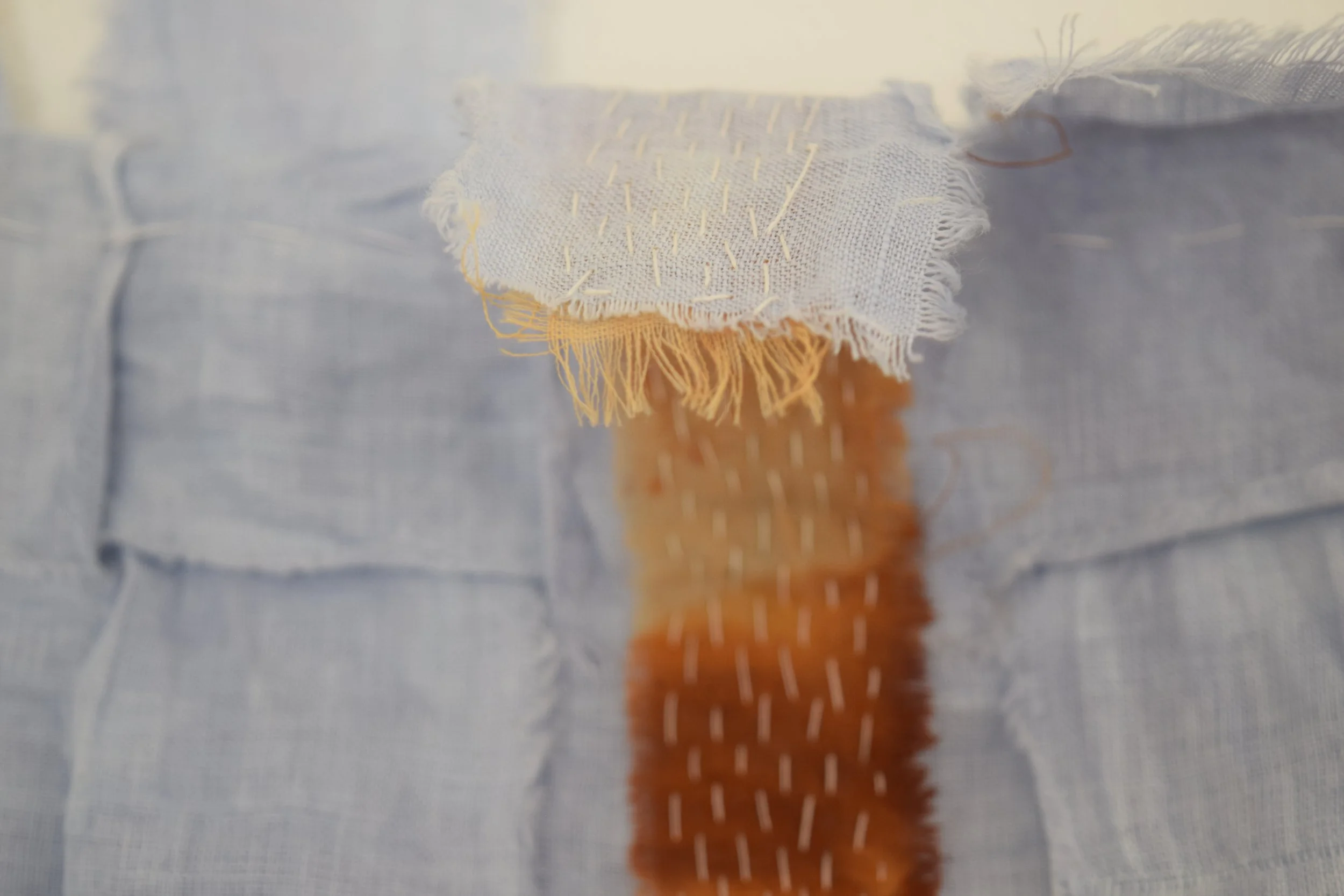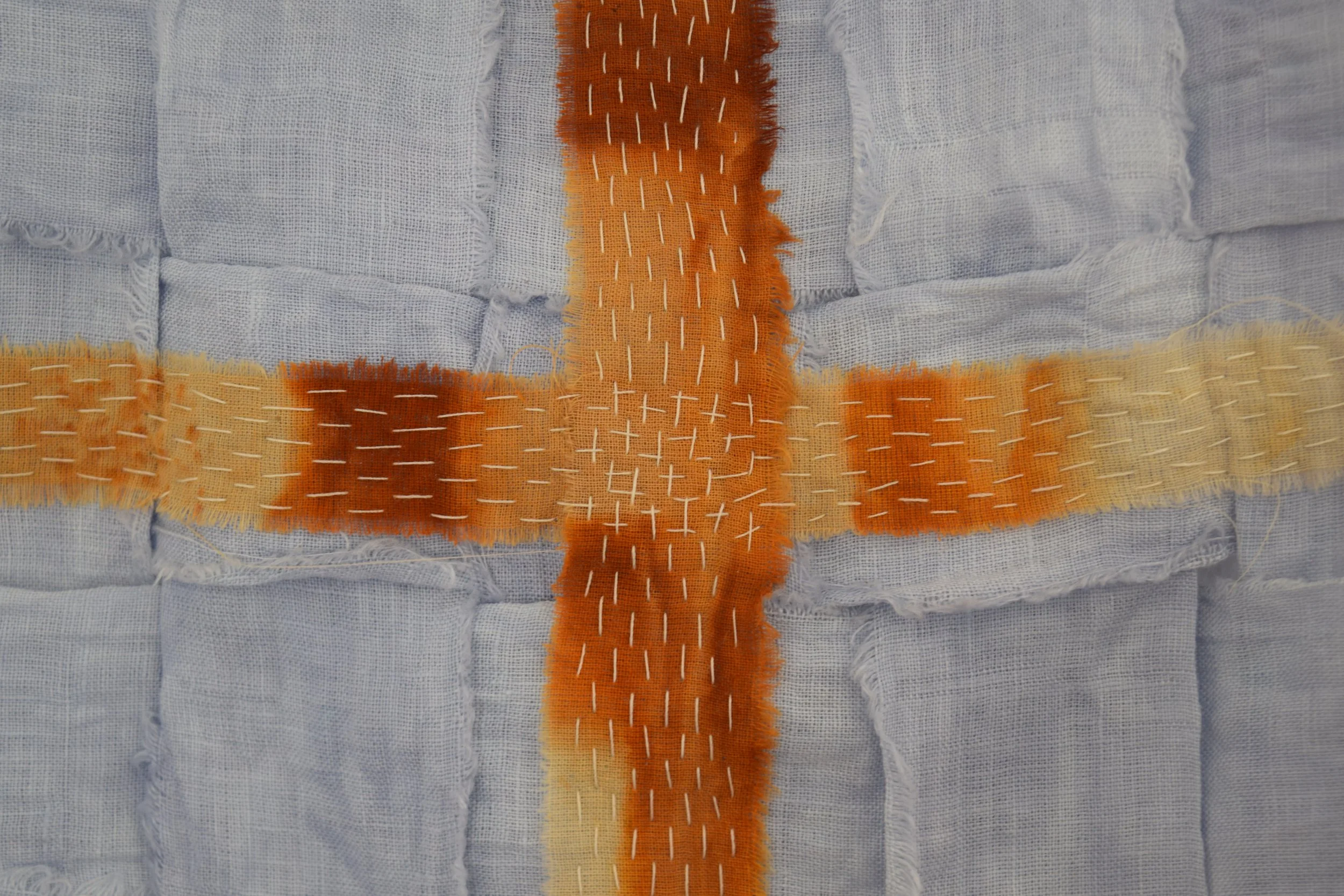






























Many Threads is a new body of work by Sophie G Nixon. Both installation and soft sculpture, this exhibition consists of large scale and wall-based textile artworks; some of which are sewn and finished neatly, others frayed and worn.
Many Threads is composed of material interventions with reclaimed textiles. Through the integration of traditional sewing techniques such as patch-working, weaving and quilting, alongside a more intuitive sewing style, their approach places process above technical perfection.
This body of work engages with the grid pattern of plain woven fabric that is formed by the warp, and the weft. In Many Threads, this grid pattern is adopted as a motif, representing relationships, bonds and connections, a material narrative that foregrounds notions of intimacy and repair.

2022, Linen bedsheet, calico, cotton embroidery floss, 150 x 20 x 2 cm
Photographed by Apurva Gupta

Photographed by Apurva Gupta
2022, reclaimed linen and viscose garment, calico, cotton embroidery floss, 15x20x2 cm

2022, calico, cotton embroidery floss, 15 x 20 x 2 cm
Photographed by Apurva Gupta

Photographed by Apurva Gupta
2022, linen remnants, rust dyed muslin, linen thread, silk thread, 32 x 33 cm
This work can be purchased for $250, send enquiries to sophiegenevievenixon@gmail.com

2022, cotton bedsheet, blood, cotton embroidery floss 55 x 33 cm
Photographed by Apurva Gupta

Photographed by Apurva Gupta
2022, hand-cut bias binding cut from bed sheets, cotton thread, polyester thread, 27 x 22 x 1 cm

Installed at Cool Change Contemporary, Barrack st, Boorloo/Perth
2022, linen bed sheet, reclaimed linen and viscose garment, cotton thread, 225 x 110 cm
This work can be purchased for $2880, with installation included in the Perth metropolitan area. Please send enquiries to sophiegenevievenixon@gmail.com

i.
[…] even you, fellow-creature, sister,
sitting across from me, dark with love,
working like me to pick apart
working with me to remake
this trailing knitted thing, this cloth of darkness,
this woman’s garment, trying to save the skein.
Adrienne Rich, “When We Dead Awaken” (1973)
Written in the zeitgeist of women’s liberation, Adrienne Rich’s poem suggests, in Julia Bryan-Wilson’s words, “a resonance between textile making (especially needlework) and crafting a self in relation to other selves – or what has been termed worldmaking” (2017, 39). This formation of identity and solidarity is fundamentally an act of repair; trying to save the skein renders this process painstaking, fragile, and imbued with the threat of loss.
ii.
Soph’s work is similarly reparative: their fabrics are recycled, repurposed, perhaps even mended, yet bearing the scars of their former lives – worn, frayed, faded, and stained. The weaving of old bedsheets invites a reading of intimacy that eschews delineation between the erotic and platonic, an affect that reminds me of Tracey Emin’s Everyone I Have Ever Slept With, where the names of past lovers are sewn alongside close friends, family members, and unborn children (Crasemann 2019). Soph’s use of the grid motif is likewise ambiguous, attesting to the strength and continuity of social bonds, yet retaining a sense of the body as injured, in need of repair, with relationships haunted by the ghosts of broken ones past.
iii.
It is generally agreed that second-wave feminism brought textiles into the gallery space, elevating the status of domestic crafts – or “women’s work” – to that of the fine art object (Baizerman 2004, 194; Bryan-Wilson 2017, 75; Chansky 2010, 688; Pentney 2008). This act of reclaiming historically feminised (and therefore denigrated) labour was by no means straightforward: the emphasis on sexual difference was not universally espoused by the feminist movement, and textile practices did not necessarily escape the tendency for second-wave feminism to exclude the perspectives of those outside the cisgendered, heterosexual, white middle-class sphere (Soph and I have spoken about our mutual wariness, being non-binary, with feminist contextualisations of our work for this reason). Indeed, the white cube gallery is not the only place to look for textile practices that resist the second wave’s said reputation: a sense of solidarity exists between queers and feminists, for example, in the self-made costumes of the drag queen – “a sphere where female and gay male labours [can] be equally valued” (Bryan-Wilson 2017, 68) – as well as the crafting-as-mourning seen in the AIDS Memorial Quilt, the world’s largest community art project (Chansky 2010, 683; National AIDS Memorial, n.d.). As fraught as the relationship between inter-generational feminisms can be, there remains the constant will to enact, as Bryan-Wilson puts it, a “politics of hand-making, world-making and self-making” (2017, 71).
iv.
Rosalind Krauss (1979, 60) proposes the centrifugal reading of art as follows:
Logically speaking, the grid extends, in all directions, to infinity. Any boundaries imposed upon it by a given painting or sculpture can only be seen – according to this logic – as arbitrary. By virtue of the grid, the given work of art is presented as a mere fragment, a tiny piece arbitrarily cropped from an infinitely larger fabric. Thus the grid operates from the work of art outward, compelling our acknowledgement of a world beyond the frame.
Applied to Soph’s work, the centrifugal reading makes sense; indeed, as an installation with multiple components, the ambient space between each work is arguably already part of the work. Both the material and their weaving of it follows a grid pattern. Their choice to incorporate the existing window of the gallery – a grid itself, opening to the world beyond the space – adds to this sense of an infinity beyond, whether we consider the frame to be the edge of the fabric or the edge of the gallery.
v.
Soph has spoken openly about the relationship between their practice and living with borderline personality disorder (BPD). For them, art can be a process of working through the difficult and intense emotions that often come with their mental illness. One of BPD’s diagnostic criteria is consistently unstable relationships, a symptom that is frequently misunderstood as a tendency to be manipulative, forming part of a broader stigmatisation that sees BPD as a series of character flaws rather than a complex emotional and interpersonal response to past traumas. The sense of connection in relationships is felt very profoundly, as is their loss; both inform Soph’s work here. This body of work began to materialise last year as they mourned two different yet significant losses: firstly, the end of their relationship with their partner, and secondly, the sudden passing of Bec O’Neill, a fellow queer artist, much loved and dearly missed.
vi.
Soph broke the news to me about Bec. They sat with me as I processed the shock. I went with them to his memorial service, and as we stood listening to his loved ones speak about his life, and their heartbreak, we held each other, sharing a jacket, huddled against the wind and the rain.
Taylor Reudavey, January 2022
References:
Crasemann, Leena. 2019. “Tracy Emin’s Tent.” Bilderfahrzeuge, February 2, 2019. https://bilderfahrzeuge.hypotheses.org/3437.
Baizerman, Suzanne. 2004. “California and the Fiber Art Revolution.” In Textile Society of America Symposium Proceedings, 193-201.
Bryan-Wilson, Julia. 2017. “Queer Handmaking.” In Fray: Art and Textile Politics, 39-105. Chicago: University of Chicago Press.
Chansky, Ricia. 2010. “A Stitch in Time: Third-Wave Feminist Reclamation of Needled Imagery.” The Journal of Popular Culture 43 (4): 681-700.
Krauss, Rosalind. 1979. “Grids.” October 9: 50-64.
National AIDS Memorial. n.d. “The History of the Quilt.” National AIDS Memorial. Accessed January 25, 2022. https://www.aidsmemorial.org/quilt-history.
Pentney, Beth-Ann. 2008. “Feminism, Activism and Knitting: Are the Fibre Arts a Viable Mode for Feminist Political Action?” Thirdspace: A Journal of Feminist Theory and Culture 8 (1). Online html: https://journals.lib.sfu.ca/index.php/thirdspace/article/view/pentney/3236.
Rich, Adrienne. 1973. Diving Into the Wreck: Poems, 1971-1972. New York: Norton.
Taylor Reudavey (b. 1994) is a non-binary artist, writer, and performer. They are of settler heritage and are currently based in Boorloo/Perth. They graduated from Curtin University with a Bachelor of Art (Fine Art) (Honours) in 2015, and from 2018 to 2021 they were a PhD (Fine Art) candidate, also at Curtin University, as a recipient of the Australian Government Research Training Program (RTP) Stipend Scholarship. Taylor has exhibited with two major institutions and four local artist-run initiatives, published nine essays for exhibition catalogues, one essay for Cactus Journal (2017), and a chapter in Remembering Artemis (2018, edited by Gemma Weston, UWA Publishing). As of 2022, they are training to be a mental health nurse.
https://www.taylorreudavey.net/